↓ Download the Full Newsletter (PDF)
Atlantic White Cedars Return to Hall’s Pond
By Randolph Meiklejohn
At the spring 2009 community work day, the Friends of Hall’s Pond undertook the planting of shrubs and trees, in one of the largest planting efforts since the renovation of the sanctuary completed in 2002. Included among these plants were Atlantic white cedars, once one of the dominant species in the original wetland but absent from Hall’s Pond for many years. The return of cedars to Hall’s Pond is another step forward, led by the Friends, in improving the quality and diversity of the sanctuary habitat.
Atlantic white cedar, Chamaecyparis thyoides, is native to the eastern United States and is related to juniper and cypress. It is occasionally confused with northern white cedar, or arborvitae, which grows in both uplands and wetlands. The Atlantic white cedar, however, requires saturated soil conditions to thrive, and is found only in wetlands. It has scaly evergreen leaves, small cones, and coarse, stringy bark. It can grow to a height of eighty feet, often with a distinctly straight trunk and in relatively pure stands.
Atlantic white cedar swamps once extended along the coast from Florida to Maine. They tend to occupy isolated hollows and inundated lowlands, in an ecosystem that (in New England) includes highbush blueberry, sweet pepperbush, and sphagnum moss. Soils are acidic, and saturated with water colored by tannin leached from fallen cedar needles.
In eastern Massachusetts, cedar swamps have been reduced by land redevelopment, and the Atlantic white cedar persists mainly in protected locations such as the Cape Cod National Seashore. In Sharon, a cedar swamp lies west of Lake Massapoag, above the aquifer which supplies water to wells in the town. Many cranberry bogs in southeastern Massachusetts were originally cedar swamps. Cedar wood was also harvested for use in building construction as shingles and exterior trim, because of its natural resistance to decay.
At Hall’s Pond, the sanctuary restoration work included expansion of wetlands beyond the borders of the pond itself, creating areas suitable for the Atlantic white cedar. The reappearance of these trees will complete the restoration of the wooded wetland, and show at a small scale the ecosystem of the larger swamp that occupied the sanctuary and Amory Park before the nineteenth century.
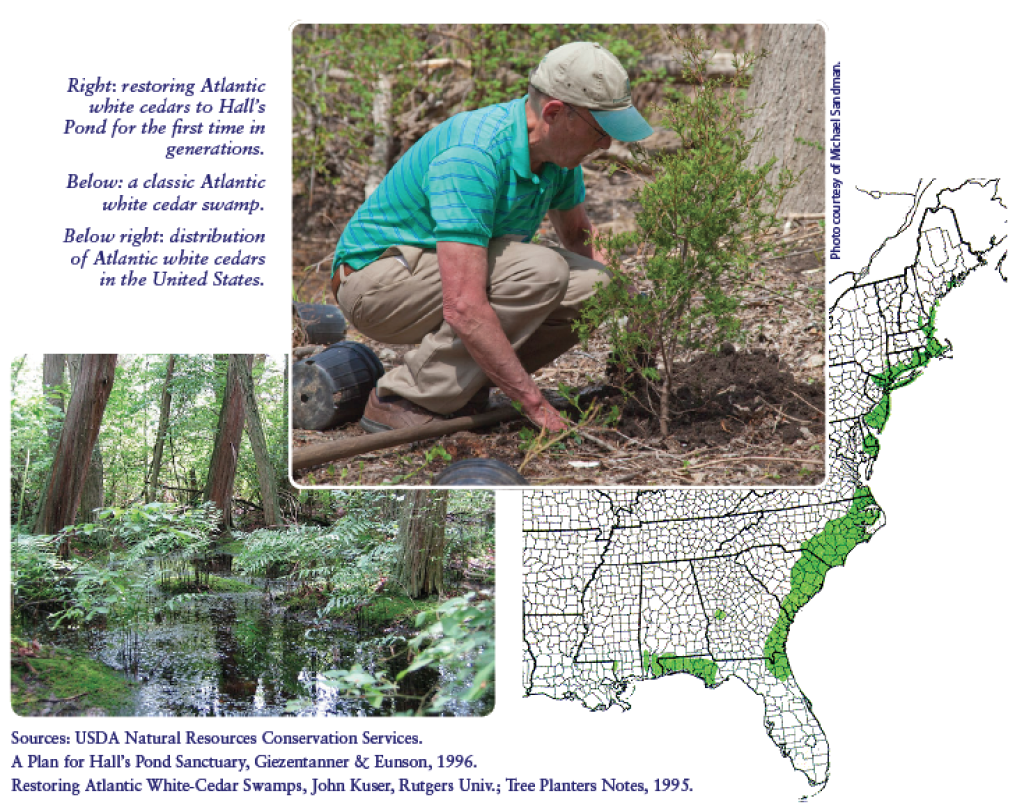
 Why Seek Birds at Hall’s Pond?
Why Seek Birds at Hall’s Pond?
By Fred Bouchard
“Why watch birds?” ask skeptical, even dismissive, acquaintances. “I’ll tell you why,” say l, reciting a list called “what birding can do for you.”
- Bring you close to nature. Birds are amazing: they’ve inspired and awed mankind in song and saga since dawn-age. Birds not only fly, but hover, wheel, soar, dive, and migrate incredible distances. Many have fascinating, complex songs and calls; resilient adaptive powers of survival; plumage that changes seasonally.
- Get you outdoors. Stretch your legs hiking the Pond’s paths and boardwalks (or even backroads, woods, mountains, beaches!) seeking elusive winged critters.
- Sharpen your eyes. Learning fine details of bird observation (field marks, habits, and movements) are critical to satisfactory (ie, accurate) bird identification.
- Retune your ears. Learn the songs, calls, and communicative noises made by the 100 species found at Hall’s Pond and 300 found in the Bay State each year. (Make that 800 nationally, and 10,000 worldwide.)
- Pique interest in botany, zoology, geography, natural history. Which berries do Cedar Waxwings eat? Which trees do Wood Ducks prefer for nest holes? Why do some Canada Geese migrate and others don’t?
- Improve map-reading, sense of direction. Finding a house on a signed street is one thing, but finding a 5” Nashville Warbler in a 10-acre park takes fine-tuning of your homing skills. Map- Quest gets you only so far.
- Teach ecology and habitat preservation. Everyone’s talking the talk of ‘green revolution’: hybrid cars, wind farms, compact fluorescents, canvas grocery bags, lights out, you name it. But who walks the walk? Birders, since before it was hot!
- Provide fun for a minute, a day, or a lifetime. You can bird actively during a ten-minute stroll or an allday hike. All you need to start is a good field-guide (Sibley’s or Peterson’s, $25) and decent binoculars).
- Travel with birds world-wide. Pop your binos in your backpack, read up on The Birds of Thailand or Costa Rica, and you can bird the globe.
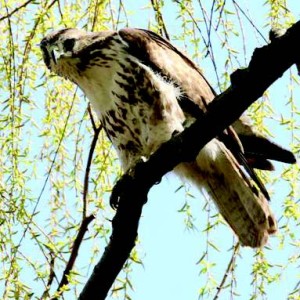 Birds year round at Hall’s Pond include many regulars. Herring Gulls overhead. Starlings, Pigeons and Mourning Doves on the ball-field. Bright-red Cardinals wheet-wheeting in the trees, House Sparrows chirping in the bushes. The local Red-tailed Hawk being pestered by crows and jays.
Birds year round at Hall’s Pond include many regulars. Herring Gulls overhead. Starlings, Pigeons and Mourning Doves on the ball-field. Bright-red Cardinals wheet-wheeting in the trees, House Sparrows chirping in the bushes. The local Red-tailed Hawk being pestered by crows and jays.
Birds pondside in May double: Chimney Swifts, Swallows (Rough-winged and Tree) skim the pond; Grackles and Redwinged Blackbirds clack in the reeds; Great Blue Heron and Black-crowned Night Heron stalk and fish. Less obvious are singing warblers (Common Yellowthroat, Northern Waterthrush) and thrushes (Hermit, Wood). Perched on a branch may be a bull-headed, quickcackling Belted Kingfisher, E. Kingbird or Baltimore Oriole. Good birdin’!
 Visitor’s Views about Hall’s Pond
Visitor’s Views about Hall’s Pond
Herons in my backyard!! How can you not love having wildlife like that so close by? Having lived for 27 years with Hall’s Pond out the back of my building, I never tire of walking through the conservation area all year long, sometimes as a destination, while other times it is just a passageway to somewhere else.
I love to go to one of the viewing platforms and check on whether one of the herons is feeding. I could stand there for hours, watching them as they intently focus on the water, looking for their next meal, as they are not afraid of having humans nearby. You really get to observe nature close up. Hall’s Pond is a little bit of country right within the town of Brookline. It is a place to walk in the woods, listen to the birds, view the pond and its wildlife, and see the wonderful formal garden. And each season paints a different beautiful picture.
Each spring and fall, I enjoy helping with the clean-up. I’ve met so many wonderful neighbors, working side by side by side with them, and I feel like I have done my small part to help maintain the conservation area.
— Priscilla Smith is a Beacon Street resident and a long-time Friend of Hall’s Pond.
 A High School Student’s Perspective
A High School Student’s Perspective
By Amy Harmsworth-Morrissey
One of my earliest memories of Hall’s Pond is walking around the pond after it had rained. It was a sunny day, yet signs of the previous rainfall were apparent in the dewy grass and the raindrops that still lingered on tree branches. While Hall’s Pond has been part of my life for as long as I can remember, I had only become aware of the Board of Hall’s Pond when my sister joined as a freshman while at Brookline High School. Following in her footsteps, I joined last year as a freshman. To be honest, I didn’t know what to expect, but was pleasantly surprised that the other more knowledgeable members of the committee were very accepting of the shy and inexperienced freshman that I was. One could say that I was nervous about joining, but I also felt proud to tell people that I was on the board.
Nature has always been one of my interests so when I joined Hall’s Pond, it was a great opportunity to do something that I felt really made a difference. During the Hall’s Pond workday, it was hard work cleaning up the sanctuary, but I also had a wonderful time meeting new people. I was shocked to see the various kinds of unusual trash and waste people had left in the garden such as big heads of cabbages and a shoe. At the same time, it saddened me to see that people would litter a sanctuary that we were working so hard to clean. While Hall’s Pond is not exactly the first place that I would think of to go to with my friends, the workday provided an opportunity for me to spend time with my friends, enjoy the natural settings around me, and do community service.
As a teenager, my days are usually filled with music, movies, YouTube videos, and in general, things that are very simulating. But Hall’s Pond provides me with a place that is just the opposite of these overly simulating mediums—a place to relax. I don’t have to worry about stressful everyday issues. One of my favorite places in Brookline was next to the weeping willow whose trunk was bent down to the ground. I am sure that I shared this spot with many who remember the tree as being unusual and memorable. I remember meeting Saba (a former board member and school friend) at Hall’s Pond. We would sit in the willow tree that overlooked the pond and the field of Amory Park. There we would talk for hours about school and friends. While the tree is no longer there, my memories remain.
Like an oasis in a desert, Hall’s Pond remains a place of respite in the middle of a busy town. But unlike an oasis, Hall’s Pond does not maintain itself. After joining the Board of Hall’s Pond, I realized how much thought goes into every decision made about the Sanctuary. These decisions ensure that Hall’s Pond is preserved year to year and help to keep the paths neat while retaining the sanctuary’s natural beauty. The Board of Hall’s Pond, the Friends of Hall’s Pond, and volunteers at the workdays all help to make Hall’s Pond a better place.
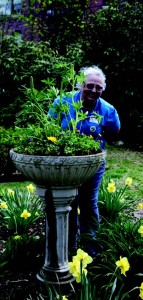 Community Work Days
Community Work Days
On a gloriously sunny and hot day forty-five volunteers joined the Friends on Sunday, April 26, to plant Spicebush (Lindera benzoin), Inkberry (Ilex glabra), Winterberry (Ilex verticillata) and Highbush blueberry (Vaccinium corymbosum); in addition to over sixty 4″ and 2′ white cedar (Chamaecyparis thyoides), native to the sanctuary. Please mark your calendars to join us next fall.
Save-the-Date
Sunday, November 22, 2009
11:00 am to 2:00 pm
Rain or Shine
Annual Meeting
Wednesday, June 10, 2009
7:00 pm – 9:00 pm
Service Award Recipients:
Nancy & Ferris Hall
Board Nominations and Committee Reports
Coolidge Corner Room at Courtyard Marriott
40 Webster Street
Brookline, MA 02446
In and Around the Garden
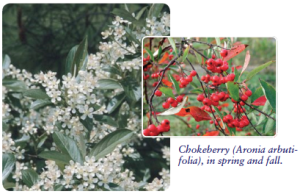 Ahh, springtime! What a pleasant change from those cold biting winter winds. Birds are singing, flowers are blooming but what about the shrubs? Looking around the sanctuary you will find many shrubs and small trees that we depend on for beauty and intrigue, but the birds and other small animals depend on for food!
Ahh, springtime! What a pleasant change from those cold biting winter winds. Birds are singing, flowers are blooming but what about the shrubs? Looking around the sanctuary you will find many shrubs and small trees that we depend on for beauty and intrigue, but the birds and other small animals depend on for food!
Aronia arbutifolia, or Chokeberry, is a berry-producing plant that is used for late winter forage by our feathered friends, and the spring flowers are visited by our bumbling buzzing friends. The spring bloom is a pleasant sight. This shrub is on the slender side, not heavy or dense. The not too showy spring bloom is a white cluster somewhat reminiscent of apple blossoms. The dark green leaves of summer let this beauty rest until fall when it really turns on the charm. This is an extremely ornamental plant that has a striking brilliant scarlet to pinkish orange glow. Then, as the leaves drop for the winter it boasts the showy red fruits that have developed from all those spring flowers.
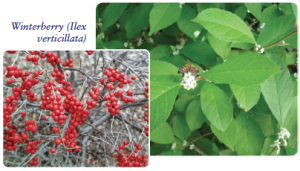 Ilex verticillata or Winterberry is an important ornamental and fruit producer too. This deciduous holly is related to the evergreen holly that can be found in every home landscape and should be used more often as it is native to our location and will tolerate some shade and wet conditions. You will need to look closely to see that it actually does bloom. It is an insignificant greenish white blossom, but very necessary in order to get those glorious red berries that are seen in every holiday decoration. This is a very hardy, native species and it is the females that are laden with the spectacular red fruits on the bare stems in late fall and winter. Look for these shrubs on your next visit to Hall’s Pond Sanctuary.
Ilex verticillata or Winterberry is an important ornamental and fruit producer too. This deciduous holly is related to the evergreen holly that can be found in every home landscape and should be used more often as it is native to our location and will tolerate some shade and wet conditions. You will need to look closely to see that it actually does bloom. It is an insignificant greenish white blossom, but very necessary in order to get those glorious red berries that are seen in every holiday decoration. This is a very hardy, native species and it is the females that are laden with the spectacular red fruits on the bare stems in late fall and winter. Look for these shrubs on your next visit to Hall’s Pond Sanctuary.
